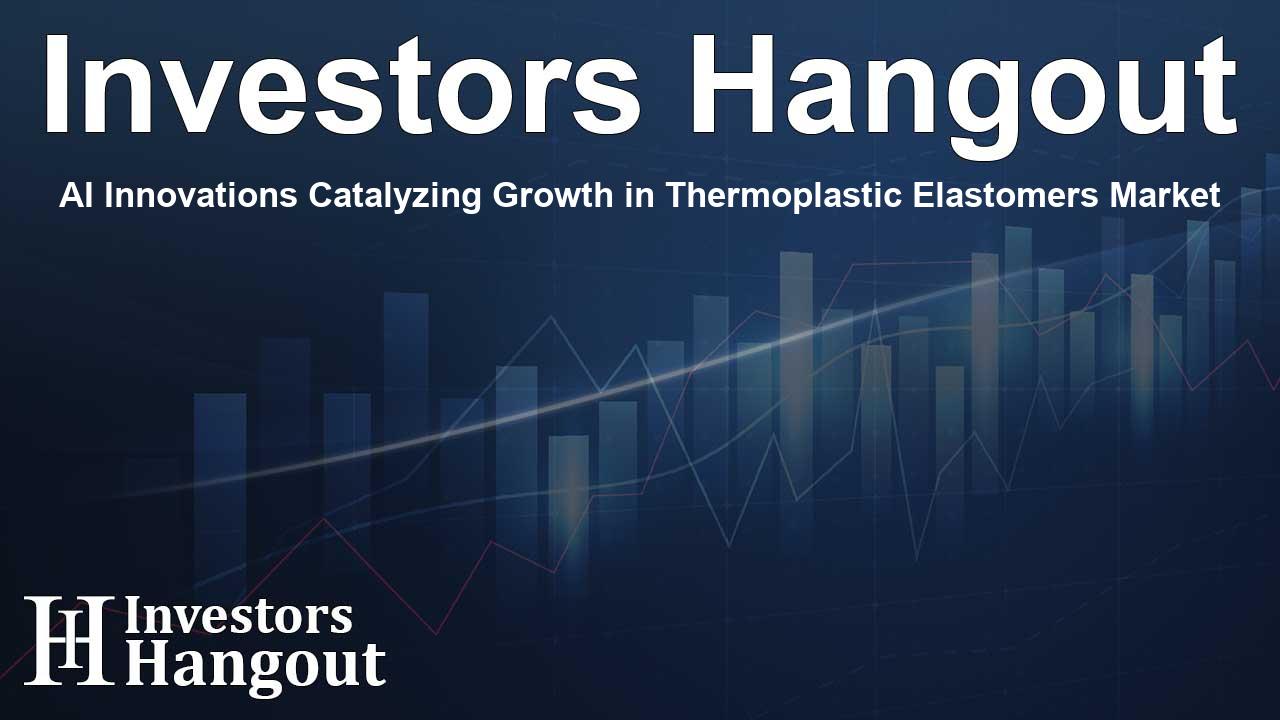AI Innovations Catalyzing Growth in Thermoplastic Elastomers Market

AI Innovations Catalyzing Growth in Thermoplastic Elastomers Market
The landscape of the Thermoplastic Elastomers (TPEs) market is undergoing a transformation, with projections indicating a robust growth trajectory. Recent analyses suggest that the global TPE market is anticipated to expand by USD 10.13 billion between 2024 and 2028, driven primarily by the establishment of new manufacturing plants and advancements in technology. The compound's significance is particularly emphasized within sectors such as automotive, consumer electronics, and construction, where lightweight and durable materials play a crucial role in product performance.
Key Market Drivers
Rise in Demand for Lightweight Materials
One of the pivotal factors propelling the growth of the TPE market is the escalating need for lightweight materials—especially in the automotive industry. The trend towards electric vehicles (EVs) and hybrid models emphasizes weight reduction, thereby enhancing energy efficiency and minimizing emissions. TPEs, renowned for their flexibility and robustness, are increasingly employed in various automotive components such as bumpers and interior fittings.
Technological Advancements and AI Integration
Technological breakthroughs and automation, particularly those involving artificial intelligence (AI), are reshaping the TPE market landscape. Companies are harnessing AI to innovate and refine product formulations, thereby driving efficiency and sustainability in manufacturing processes. Notable players in the market, like Lubrizol, are leading efforts to develop high-performance TPE solutions tailored to the evolving needs of multiple industries. The integration of AI is expected to enhance production capacity and optimize resource usage, promoting the adoption of these elastomers in diverse applications.
Industry Applications
Diverse Uses Across Key Sectors
Beyond the automotive realm, TPEs are garnering recognition in the consumer electronics sector, where they are used in mobile phone cases and cables. Their aesthetic appeal combined with excellent performance makes them a preferred choice. Additionally, TPEs are making their mark in the healthcare industry, as they are utilized in medical tubing, connectors, and various surgical tools that require biocompatibility and thermal stability.
Construction Sector Growth
The construction industry is actively embracing TPEs for applications that range from gaskets to wire insulation. As sustainability becomes a paramount concern, the eco-friendly characteristics of bio-based TPEs, created from renewable resources such as corn and palm oil, are appealing to manufacturers seeking to enhance their green credentials.
Challenges Facing the Market
Regulatory Compliance Challenges
While the TPE market is flourishing, it faces challenges, notably related to compliance with stringent regulations across various sectors. For instance, specific applications in the medical and food industries must adhere to policies set by organizations like the U.S. Food and Drug Administration (FDA), which require exhaustive testing and certification processes. These regulatory demands can impose significant operational costs on manufacturers, impacting market entry and product development timelines.
Future Outlook
The future of the thermoplastic elastomers market appears promising as the demand for lightweight and high-performance materials accelerates. Research and investment in innovative TPE formulations will remain crucial as industries adjust to changing consumer expectations and regulatory environments. Additionally, the collaboration between manufacturers and AI development teams is likely to spark further innovations that will challenge traditional material performance metrics, paving the way for the next generation of TPEs.
Frequently Asked Questions
What are thermoplastic elastomers and their main uses?
Thermoplastic elastomers (TPEs) are versatile materials used in various applications due to their combination of plastic-like processability and rubber-like elasticity. Common uses include automotive parts, consumer electronics, and medical devices.
How is AI influencing the thermoplastic elastomers market?
AI is facilitating innovation in TPE formulations and manufacturing processes, leading to better efficiency, sustainability, and performance in products.
What are the main benefits of using TPEs in the automotive industry?
TPEs offer lightweight properties, enhanced energy efficiency, and are suitable for a variety of automotive applications, making them ideal for electric and hybrid vehicles.
What challenges does the TPE market currently face?
The TPE market faces challenges related to regulatory compliance, particularly in the medical and food industries, which require rigorous testing and certification standards.
What is the projected growth for the TPE market?
The TPE market is projected to grow significantly, with an expected increase of USD 10.13 billion from 2024 to 2028, driven by the rising demand for lightweight materials and technological advancements.
About Investors Hangout
Investors Hangout is a leading online stock forum for financial discussion and learning, offering a wide range of free tools and resources. It draws in traders of all levels, who exchange market knowledge, investigate trading tactics, and keep an eye on industry developments in real time. Featuring financial articles, stock message boards, quotes, charts, company profiles, and live news updates. Through cooperative learning and a wealth of informational resources, it helps users from novices creating their first portfolios to experts honing their techniques. Join Investors Hangout today: https://investorshangout.com/
Disclaimer: The content of this article is solely for general informational purposes only; it does not represent legal, financial, or investment advice. Investors Hangout does not offer financial advice; the author is not a licensed financial advisor. Consult a qualified advisor before making any financial or investment decisions based on this article. The author's interpretation of publicly available data shapes the opinions presented here; as a result, they should not be taken as advice to purchase, sell, or hold any securities mentioned or any other investments. The author does not guarantee the accuracy, completeness, or timeliness of any material, providing it "as is." Information and market conditions may change; past performance is not indicative of future outcomes. If any of the material offered here is inaccurate, please contact us for corrections.